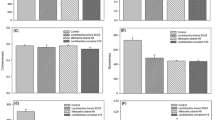Abstract
Eight lactic acid bacteria were isolated from fermenting maize meal. They were identified as Lactobacillus brevis, L. casei, L. fermentum, Pediococcus acidilacti, P. pentosaceus, Lactobacillus spp. I and Pediococcus spp. I and II. L. brevis and Lactobacillus spp. I isolated from the spontaneously fermented maize meal together with L. brevis isolated from rye sour dough and L. plantarum from ogi, a fermented maize gruel, were selected as starter organisms. There was a decrease in the final pH from 4.9 to 3.8 and an increase in the acid equivalent and temperature of the spontaneously-generated sour maize meal at the end of 24h fermentation. There was a decrease in the pH and moisture content of the sour maize breads relative to the conventional wheat bread. An improvement in the shelf-life of the bread samples was also obtained. Crude protein values of the sour maize breads were between 4.36% and 8.87%, while crude fat contents ranged between 3.66% to 7.67%. The ash contents increased from 2.29% to 2.54% while total carbohydrate values were between 46.31% and 65.3%. Calcium, phosphorus and potassium contents ranged from 0.015, 0.26 and 0.018% to 0.036, 0.47 and 0.036% respectively. Physical examination of the bread samples showed that all were cracked and relatively hard. Weight, height and volume ranged from 316 to 380g; 4.2 to 5.2cm and 200 to 320cm3 respectively. Statistical analysis of the sensory attributes revealed a consumer acceptance of the sour maize breads, although ranking test showed preference for the baker's yeast leavened bread that served as a control.
Similar content being viewed by others
References
Akinrele, I.A. 1970 Fermentation studies on maize during the preparation of a traditional African starch cake food. Journal of Science, Food and Agriculture 21, 619–625.
Akobundu, E.N.T., Ubabaonu, C.N. & Ndufuh, C.E. 1988 Studies on the baking potential of non-wheat composite flours. Journal of Food Science & Technology 25, 211–214.
A.O.A.C. 1980 Association of Official Analytical Chemists. 13th Edn. Washington D.C.
Asselbergs, E.A. 1973 In Composite Flour Programme. Documentation Package 1, 5–6 FAO, Rome.
Brummer, J.M. 1974 Backereitechnologische Masnahmen Zur verminderung der Schimmenlan falligkeit von Brot. Getreide Mehl und Brot 28, 45–49.
Bureng, P.L. & Olatunji, O.O. 1992 Wheatless Bread Development and Extension. Technical Publication, Federal Institute of Industrial Research (FIIRO), Oshodi, Nigeria.
Desai, B.B. & Salunkhe, D.K. 1986 ``Dhokla and Khaman'' In Legume-Based Fermented Foods, eds Reddy, N.R., Pierson, M.D. & Salunkhe, D.K. pp. 161–171. Boca Raton: CRC Press
Halm, M., Lillie A., Sorenson, A.K. & Jakobsen, M. 1993 Microbiological an aromatic characteristics of fermented maize doughs for ``kenkey'' production in Ghana. International Journal of Food Microbiology 19, 135–143.
Hounhouigan, D.J., Robertonout, M.J., Nago, C.M., Houben, J.H. & Rombouts, F.M. 1993 Composition and microbiological and physical attributes of ma. we, a fermented maize dough from Benin. International Journal of Food Science & Technology 28, 513–517.
Inglett, G.E. 1974 Wheat: Production and Utilization. pp. 3–12. New York: The AVI Publishing Company.
Jacobs, M.B. 1951 The Chemical Analysis of Foods and Food Products. London: D. van Nostrand.
Kandler, O. & Weiss, N. 1986 Gram positive rods. In Bergey's Manual of Systematic Bacteriology, vol. 2, eds Sneath, P.H.A., Nair, M.S., Sharpe, M.E. & Holt, J.G. pp. 1208–1234. Baltimore: Williams and Wilkins.
Lonner, C. 1988 Starter cultures for rye sour doughs. PhD dissertation. Department of Applied Microbiology, University of Lund, Sweden.
Lonner, C. & Preve-Akesson, K. 1988 Acidification properties of lactic acid bacteria in rye sour doughs. Food Microbiology 5, 43–58.
Lonner C., Welander, T., Molin, N., & Dostale, M. 1986 The microflora in a sour dough started spontaneously on typical Swedish rye meal. Food Microbiology 3, 3–12.
Martinez-Anaya, M.A., Pitarch, B., Bayarri, P. & Benedito de Barber, C. 1990 Microflora of the sour doughs of wheat flour bread: Interactions between yeasts and lactic acid bacteria in wheat doughs and their effects on bread quality. Cereal Chemistry 67, 85–91.
Mrdeza, L. 1978 Trends for speciality breads Cereal Foods World 23, 635.
Mukherjee, S.K., Albury, M.N., Pederson, C.S., Van Veen, A.G. & Steinkraus, K.H. 1965 Role of Leuconostoc mesenteroides in leavening the batter of ``idli'' a fermented food of India. Applied Microbiology 13, 227–231.
Okoruwa, E.A. 1995 Utilization and processing of maize. IITA Research Guide 35, 1–22.
Oyeyiola, G.P. 1990 Microbiological and biochemical changes during the fermentation of maize grains for masa production. World Journal of Microbiology and Biotechnology 6, 171–177.
Padhye, V.W. & Salunkhe, D.K. 1978 Biochemical studies on black grain (Phaseolus mungo L.) III. Fermentation of the black grain and rice blend and its influence on the in vitro digestibility of the proteins. Journal of Food Biochemistry 2, 327–330.
Pederson, C.S. 1971 Microbiology of Food Fermentations. Westport, Connecticut: AVI Publishing Co.
Reddy, N.R., Pierson, M.D. & Salunkhe, D.K. 1986 ``Idli'' In Legume-Based Fermented Foods, eds Redely, N.R., Pierson, M.D. & Salunkhe, D.K. pp. 145–160. Boca Raton: CRC Press.
Reed, G. 1981 Use of Microbial Cultures: Yeast Products. Food Technology 35, 89–94.
Spicher, G., Stephen, H.S. 1982 Hanbuch Sauerteig: Biologie, Biochemie. Hamburg: Technologie Hamburg BBV.
Stauffer, C.E. 1991 Functional additives for Bakery Foods New York: Van Nostrand Reinhold.
Tansey, M.R. 1973 Isolation of thermophilic fungi from alligator nesting material. Mycologia 65, 595–601.
Wacher, C. Canas, A., Cook, D.E., Barzana, E. & Owens, J.D. 1993 Sources of Microorganisms in pozol, a traditional Mexican fermented maize dough. Biotechnology 9, 269–274.
Yin, Y. & Walker, C.E. 1995 A quality comparison of breads baked by conventional versus non conventional oven: a review. Journal of Science, Food and Agriculture 67, 283–291.
Author information
Authors and Affiliations
Rights and permissions
About this article
Cite this article
Sanni, A., Onilude, A. & Fatungase, M. Production of sour maize bread using starter-cultures. World Journal of Microbiology and Biotechnology 14, 101–106 (1997). https://doi.org/10.1023/A:1008836803338
Issue Date:
DOI: https://doi.org/10.1023/A:1008836803338




